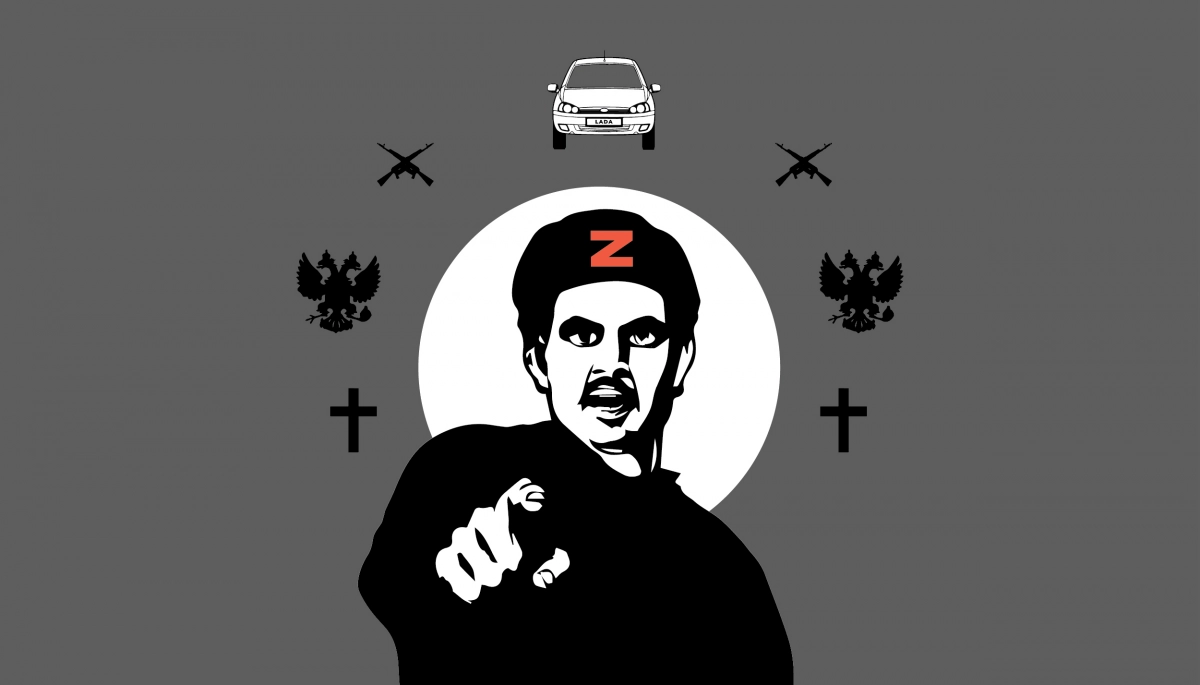

Українською читайте тут.
In the autumn of 2022, Russia conducted an overt civilian mobilization for the first and last time. Putin's decree of 21 September 2022, "On the Announcement of Partial Mobilisation in the Russian Federation," is still in force, in particular, by making it impossible to leave the army at the end of the contract. On 31 October 2022, the Russian Ministry of Defence announced the end of the period for issuing summons for military conscription. Since then, Russia has been recruiting contract soldiers through pressure and incentives. According to the New York Times, which cites information from various Western intelligence agencies, Russia is currently mobilizing 25-30,000 recruits a month in this way and losing about the same number on the battlefield. "This allowed its army to continue sending troops wave after wave, hoping to overcome Ukrainian defenses and break through the trench lines,” the article says. British intelligence data show that in May 2024, Russia lost more than 1,200 soldiers killed and wounded every day, the highest figure since February 2022. In total, since the start of the full-scale invasion as of 31 May 2024, Russia has lost about half a million soldiers killed and wounded, according to these figures.
Propaganda designed to encourage people to kill in a war of aggression, at high risk of being killed themselves, has its audience and focus. The messages that agitational propaganda disseminates to domestic audiences to cement the regime or to gullible, vulnerable global audiences are unlikely to work here. We have examined the most common propaganda videos calling for enlistment in the Russian army and identified their aesthetic and narrative characteristics.
Geographical fetishism
Russia is the largest country in the world, with more than a thousand cities spread across 11 time zones. It is all the more paradoxical that one of the most common narratives of recruitment videos is the cultivation of the dream of Russians living in Ukrainian cities. As early as September 2023, a series of videos in a similar style began to circulate on Russian networks, generally characterized by the mental occupation of Ukrainian cities and their imaginary incorporation into the Russian world. In the stories about Russian soldiers, Ukrainian cities are framed as a promised land, a great dream of a new life in the occupied territories after the war.
One of the videos shows Russian soldiers reloading their machine guns in a trench in the middle of an active battlefield and having a leisurely conversation:
— "Do you happen to know where the Pechersk hills in Kiev are?"
— "It's in the [city] center; my aunt lives there. It's a cool neighborhood. Why?"
— "I have a dream. I want to buy a flat there. Once the war is over, we'll get Kiev back, and I'll move my family there."
— "Well, I'll go to Odessa, I love the sea…"
At the end of the video, there is the line, "Choose the city of your dreams," with Ukrainian cities listed in the background, including Kharkiv, Poltava, Chernivtsi, Kyiv, Sumy, and Kherson.
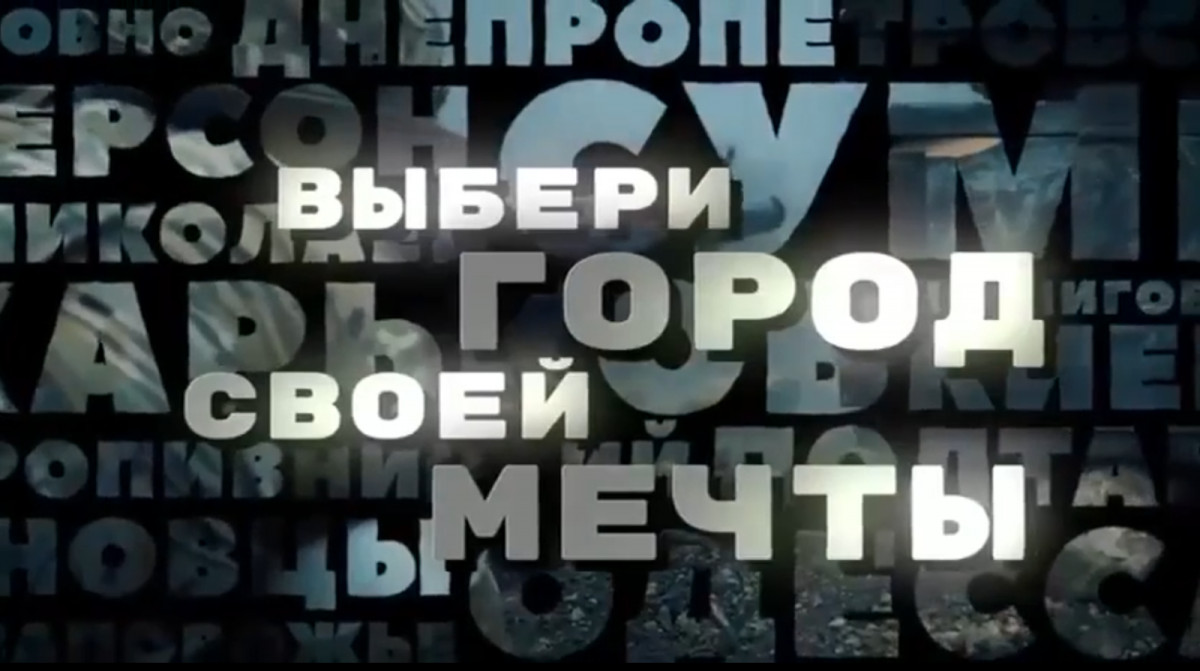
Choose the city of your dreams
Source: RIA KATYUSHA propaganda Telegram channel
In another video, two Russian soldiers speak about getting a plot of land in Odesa. The dialogue is framed as if the invaders were already in Odesa (one of the men uses the adverb “here”).
— "And I will stay here, in Odessa, after the war. My family comes from here. I'm basically coming back home."
— "Are you going to buy land here?"
— "No, they'll just give me a hectare, like in the Far East. And Special Operation participants will get it first."
After that, the background, common for this series of videos, is shown, with a list of Ukrainian cities and, this time, the inscription: “We are fighting for our land!”. As seen from the dialogue, this literally refers to a piece of Ukrainian land for each Russian soldier.
As mentioned in the video, the Federal Government's Far Eastern Hectare program provides Russian citizens with free land allocation in the Far Eastern Federal District. Launched in 2016, the initiative aimed to stimulate the development of the economically weak and sparsely populated Russian Far East and ensure the demographic dispersion of the central regions. In this case, settling in Ukrainian cities populated by Ukrainians is proposed as a viable alternative to the Far East.
Throughout the series, participation in the war indirectly escapes the dysfunctional Russian reality in favor of an imagined prosperous future in Ukraine. Among the numerous Russian cities, the best ones are not Russian but Ukrainian cities, which are promised to someday become Russian in this fantasy.
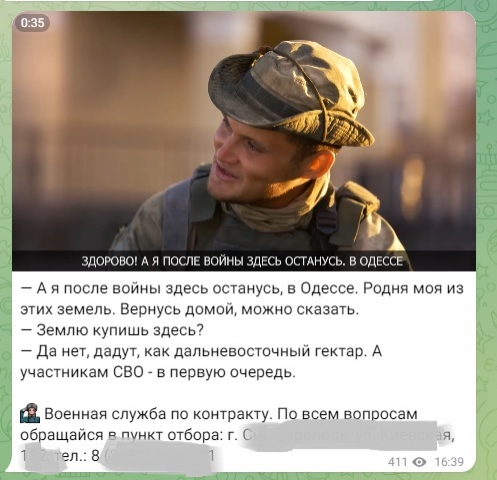
Cool! And I will stay here after the war – in Odessa.
[Text of the message]
— “After the war I will stay here, in Odessa. My family comes from here. I'm basically coming back home.”
— “Are you going to buy land here?”
— “No, they'll just give me a hectare, like in the Far East. And Special Operation participants will get it first.”
Contract military service. If you have any questions, please contact the enlistment office: [address blurred]
Source: propaganda Telegram channel “Millet Z Crimea”.

Fighting for our land!
Source: propaganda Telegram channel “Millet Z Crimea”.
Another video in the series reveals the geographical synonymization of Ukrainian and Russian cities and the blurring of borders due to the rejection of Ukrainian decommunization. In this video, a Russian soldier plays cities with a captured teenager whose hands and feet are tied. The point of the game is to name a town beginning with the letter that ends the name of the previous one.
The Russians named Russian settlements, and the Ukrainian teenagers named Ukrainian settlements.
— "Novorossiysk. You start with a 'k'."
— "Kiev."
— "Volgograd."
— "Dnepr."
— "There is no such city! There is Dnepropetrovsk," a Russian soldier shouts in a preachy, irritated tone.
At the end of the video, the motto "Returning the names of our cities" appears on a background of Ukrainian city names, familiar from other videos, and the address of a military enlistment office in one of the cities of occupied Crimea. By "our name," the propagandists mean the Soviet name Dnipropetrovsk, which was changed to Dnipro in 2016 in the decommunization.
Decommunisation is one of the trigger issues for Russian propagandists. In their view, the desire to fight Ukrainian place names will also motivate Russians to join the Russian army. However, the video series' common background with a list of Ukrainian cities includes the decommunized name Kropyvnytskyi, not the Soviet name Kirovohrad, which the city had until 2016. It shows how unfamiliar the makers of the videos are with the Ukrainian cities they are so eager to populate.
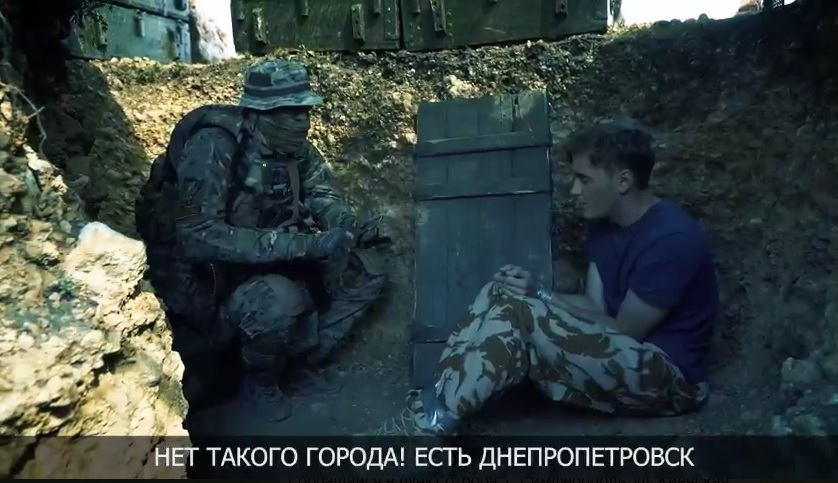
There is no such city! There is Dnipropetrovsk
Source: propaganda Telegram channel “Millet Z Crimea”.
A recent video, dated June 2024, not from the previous series, shows the aggressive occupation of Ukrainian land through the russification of place names. One of the videos shows two utility workers, one younger and one older, replacing a damaged Ukrainian-language sign "Avdiivka" (Ukrainian transliteration) with an undamaged new one reading "Avdeevka" (Russian transliteration). The old sign is thrown into a pile of already dismantled signs, where the damaged "Maryinka" (Ukrainian transliteration) sign is also visible.
“Are there many more?” the younger worker asks the older one.
"A lot. But we must get the job done," the older man replies. The film then shows the new Russian-language signs for the following Ukrainian towns, prepared in a truck: "Chasov Yar", "Zaporozhye" (both in Russian transliteration), and "Kherson", with the transliteration of the latter name being the same in Russian and Ukrainian. The video ends with the line "Work, brothers" against a backdrop of a convoy of Russian military equipment and aircraft.
In this recent video, Russia's invasion plans are narrowed down to the cities that Putin demanded to be recognized as Russian in his latest 'Zaporizhzhia-Kherson ultimatum' of 14 June, issued on the eve of the peace summit organized by Ukraine. Kherson was the only regional center that Russia managed to occupy from the start of the full-scale invasion and from which Russian troops were driven out in November 2022. Since then, at the cost of tens of thousands of troops, Russia has only managed to occupy smaller towns, such as Bakhmut or Avdiivka, which were almost destroyed by shelling during the attacks. It makes the invaders' scaled-down promises to "get the job done" in Kherson and Zaporizhzhya look unrealistically pretentious.
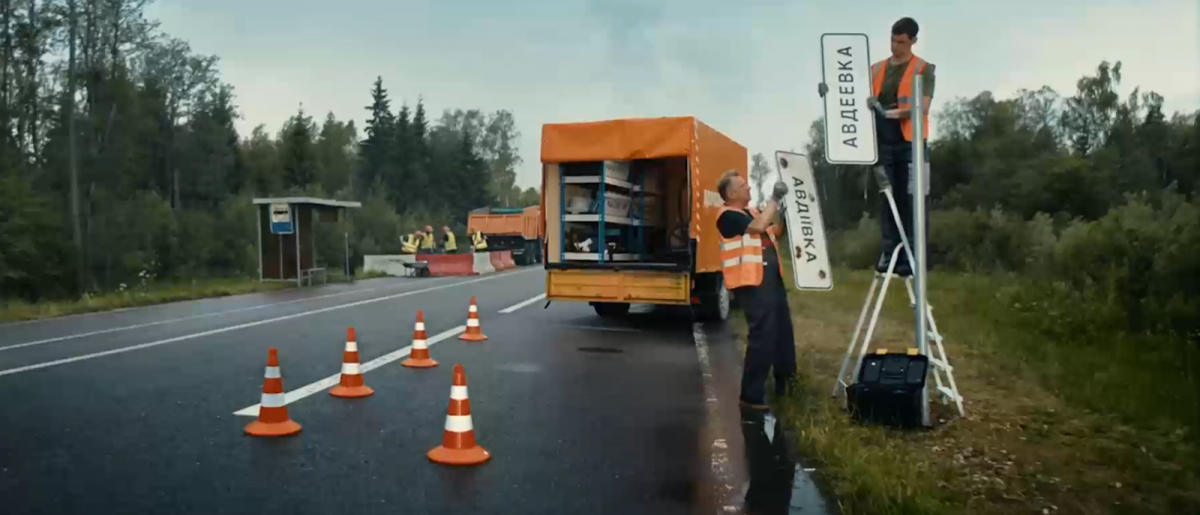
Source: Kotsnews propaganda Telegram channel
The video illustrates the routinization of aggressive warfare as work, albeit important. On the one hand, this intends to morally reconcile potential recruits who no longer come to kill and be killed but to be hired for a responsible "job". On the other hand, such a euphemism also reconciles other spectators by distracting them from the facts of numerous war crimes committed by Russians in Ukraine.
Murderous machismo
Another recruitment campaign used videos and posters to promote contempt for civilian, "unmanly" professions in favor of "masculine" participation in the war. One video shows a supermarket security guard, a gym trainer, and a taxi driver. Each is shown in turn in their civilian professions and then in the romanticized macho image of a Russian military man. Dismissive phrases accompany the footage of them in their civilian occupations: "Is this the kind of defender you dreamed of becoming?" to the security guard, "Is this where your strength lies?" to the trainer, and "Is this the road you wanted to take?" to the taxi driver. The video ends with a call: "You are a man. Be one." It then shows the promised monthly salary of a contract soldier, starting at 204,000 rubles.
Such advertisements generally mention the income promised to recruits. Aimed at working-class people, the advertising campaign offers both quick financial gain and moral justification for participation in aggressive war by claiming that it fulfills one's masculinity. The result is the promotion of war as the only thing worthy of a man—an archaic notion in some cultures.
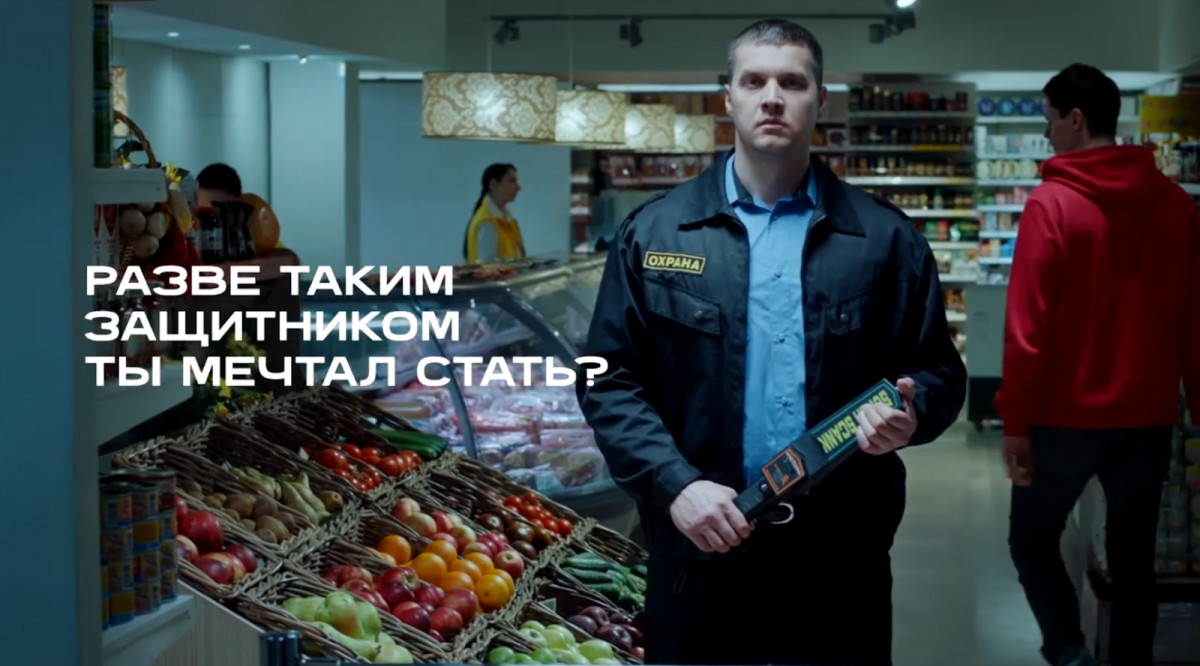
Is this the kind of defender you dreamed of becoming?
Source: KP.RU: Komsomolskaya Pravda page on dzen.ru
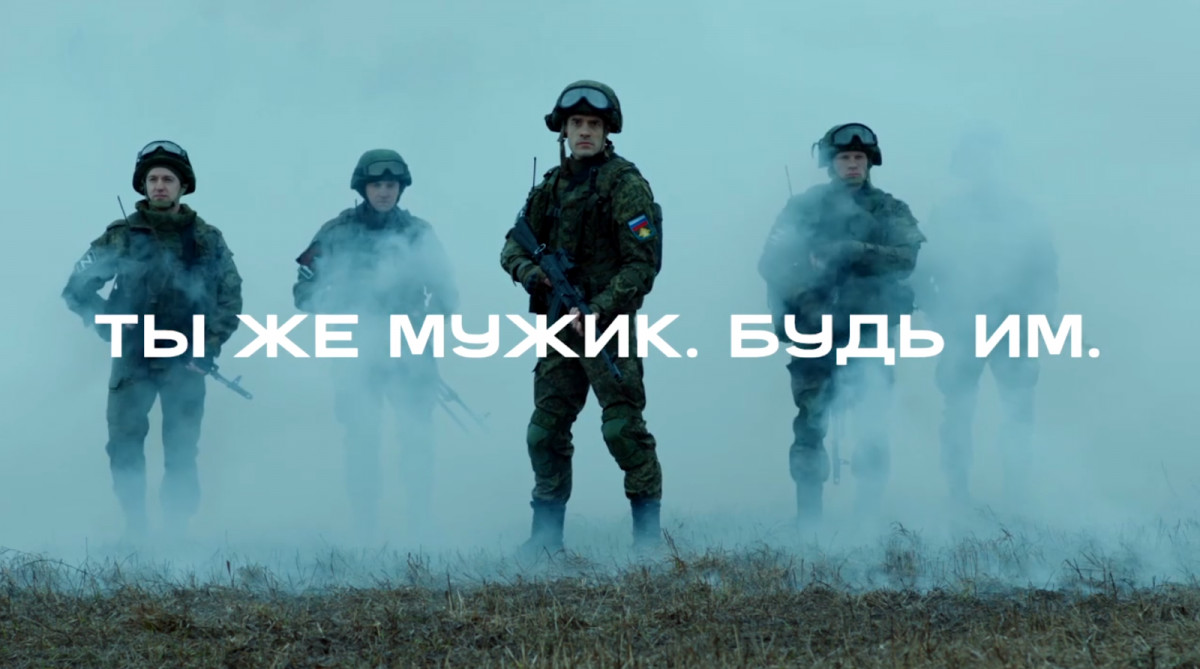
You are a man. Be one.

[Text above] Army of Russia
[Text below] A real normal job
Source: Website of state and municipal services in Rostov region (Russia)
Prigozhin’s shock value
The recruitment videos of Yevgeny Prigozhin's Wagner terrorist group, which built their image by contrasting themselves with the bland bureaucracy and poster campaigns of the Ministry of Defence, had a style all their own. Wagner's recruitment videos were characterized by their leader's trademark garishness. For example, Wagner bought an ad on one of the most popular pornography websites, PornHub. A 15-second video rolled before the pornographic videos began to play. Against the background of a woman's lips holding a lollipop, the text was read in a playful, girlish voice: "We are the world's best f**king private army. We recruit fighters from every region of Russia. Stop j**king off and come work for PMC Wagner."
Another of Prigozhin’s innovations was releasing an English-language recruitment video ostensibly aimed at US citizens, Russia’s main ideological enemy. The troll-like video was launched after the US Treasury Department's Office of Foreign Assets Control declared Wagner Group a transnational criminal organization. It suggested that US citizens should realize that Russia is the only country currently "fighting evil". Furthermore, to bring back the "Great America," one should go to war for Russia as part of Wagner.

Wagner advertisement on PornHub. Source: ChTD Telegram channel

If you’re a true patriot of the future Great America
English-language advertisement for Wagner. Source: Rutube
Wagner's primary recruiting resource during the full-scale invasion was not Americans or visitors to porn sites. Still, prisoners were given a choice between a bad and an even worse option. According to an investigation by Mediazona and the BBC Russian Service, based on Wagner documentation available to them, Prigozhin's organization managed to recruit at least 48,366 prisoners from Russian penal colonies to fight in Ukraine. The group's most important military operation was the battle of Bakhmut, which the members of the Wagner group themselves called the "Bakhmut Meat Grinder". Documents show that the Wagner Group lost at least 19547 men in the battle, which lasted 327 days. Of these, 17,175 were prisoners, while only 2,372 were willing conscripts.
Overall, according to the Wagner accounts obtained by journalists, one in three prisoners did not return from the "Bakhmut Meat Grinder" – 35.5% of the total number of recruits.
In the run-up to Putin’s last regular “election” in March 2024, campaign ads, including agitational propaganda campaign videos, justified the need to vote for him with an eclectic mix of narratives. Cementing the regime was proposed as a means of shielding against hostile Western values, including feminism and the LGBT movement, preserving Russian sovereignty in confrontation with the United States, and preserving economic stability. Produced for the general public, these videos were also adorned by an eclectic entertainment aesthetic. In most recruitment videos, however, the complex propaganda constructs of agitational propaganda are almost completely absent. Even the cult of heroes, as well as any mentions of justice, is uncommon. An invitation to an aggressive war seems to require a certain level of propagandistic honesty – or it will not be accepted. The themes are more primitive yet revealing. There is a laconic aesthetic and a minimum of statements. All they promise is financial reward, moral "forgiveness" through participation in supposedly respectable men's work, and an indirect but pretty transparent appeal to the dream of escaping Russian reality by settling and plundering Ukrainian cities. Significantly, in contrast to Moscow's official rhetoric, the goal of conquering unoccupied Ukraine is openly acknowledged, even if it means long work. It also shows a complete disregard for civilian lifestyles. It is the recruitment videos for the Russian army that best convey the ideological essence of the regime without any unnecessary additives – a barbaric expansionism that routinizes violence.
Main page illustration and infographic credits: Natalia Lobach

